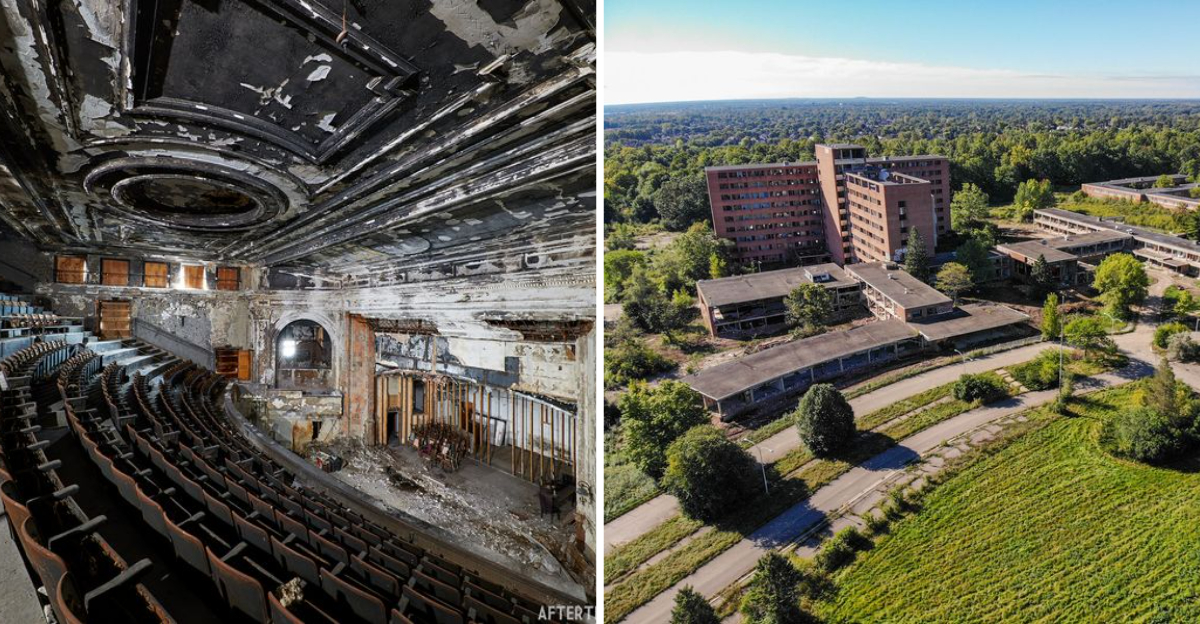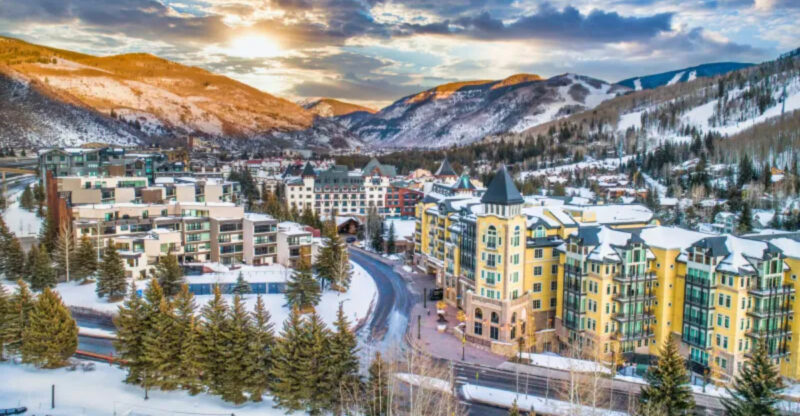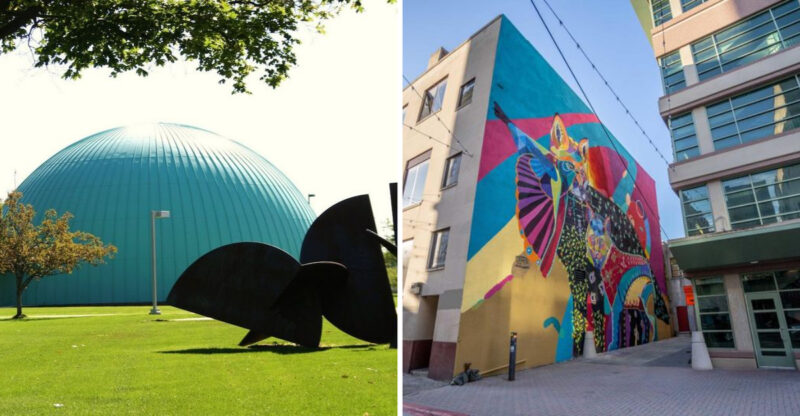15 Michigan Abandonments That Tell Stories Time Left Behind

Michigan holds secrets from the past in the form of abandoned buildings and forgotten places scattered across the state.
From old factories to theme parks left to decay, these sites whisper stories of people who once filled them with life and purpose. Exploring these locations helps us understand how communities changed over time and why certain dreams faded away.
1. Fayette Historic State Park
Once upon a time, this thriving iron-smelting community buzzed with workers and families building a future on the Garden Peninsula. From the 1860s through the 1890s, massive furnaces roared day and night, transforming raw ore into valuable iron that helped build America.
Walking through Fayette today feels like stepping into a time capsule. Restored homes, warehouses, and the towering furnace structure still stand against the backdrop of stunning limestone cliffs. It’s amazing how these buildings survived more than a century of Michigan weather.
Visitors can wander freely through this outdoor museum and imagine what life was like for frontier families. The park offers a rare chance to see industrial history preserved in its original setting.
2. Belle Isle Zoo
Did you know that generations of Detroit families created memories at this beloved zoo before it closed in 2002? For over a century, children laughed at playful animals and parents enjoyed peaceful walks through carefully maintained grounds.
Budget cuts forced the city to shut down operations, leaving behind empty enclosures and forgotten pathways. Nature quickly moved in, wrapping rusted cages in vines and transforming concrete paths into wild gardens. The silence now feels heavy compared to the joyful sounds that once filled this space.
Though the zoo stands empty, it reminds us how economic challenges can erase cherished community gathering places. Some locals still remember feeding the seals or watching the polar bears swim.
3. Michigan Central Station
If you want to see a symbol of both glory and decline, this massive train station tells the whole story. Built in 1913, it proudly held the title of the world’s tallest train station, welcoming thousands of travelers daily through its grand halls.
After closing in 1988, the building became a haunting reminder of Detroit’s struggles. Broken windows stared out at the city like empty eyes, and graffiti covered once-elegant walls. Urban explorers snuck inside to photograph the decay, making it famous worldwide.
Hope arrived recently as restoration teams began bringing this architectural masterpiece back to life. The project shows how abandoned places can find new purposes when communities refuse to give up.
4. Packard Automotive Plant
When this sprawling factory opened between 1903 and 1911, it represented the cutting edge of automobile manufacturing technology. Engineers designed the complex with innovative features that made car production faster and more efficient than anyone thought possible.
After operations stopped in 1958, the buildings began a slow transformation into one of the world’s largest abandoned sites. Floors collapsed, walls crumbled, and weather gradually reclaimed the space where thousands once worked. Urban photographers captured haunting images of machinery frozen in time.
The plant’s sheer size makes it hard to comprehend until you stand before it. Parts of the complex have been demolished, but remaining sections continue drawing curious visitors fascinated by industrial history.
5. Prehistoric Forest
Are you ready to discover a place where dinosaurs still roam, though covered in moss and forgotten by time? Established during the 1960s, this quirky roadside attraction delighted families with life-sized prehistoric creatures scattered through wooded trails.
Kids squealed with excitement pointing at towering T-Rex models and gentle brontosaurus displays. The park offered adventure and education wrapped in colorful fiberglass sculptures that seemed magical to young imaginations. Summer vacations often included stops here for photos and ice cream.
By the late 1990s, the park closed its gates for good, leaving the dinosaurs to weather and decay. Today, these eerie green-tinted giants stand as monuments to roadside America’s golden age of family tourism.
6. Fisher Body Plant 21
How does a building that once produced thousands of car bodies end up silent and forgotten? This massive factory served as a crucial part of Detroit’s automotive empire, crafting the outer shells that protected drivers and passengers across America.
Workers clocked in daily, operating heavy machinery and assembling parts with precision and pride. The sound of metal presses and welding torches created a constant industrial symphony. Paychecks from this plant supported entire neighborhoods and funded countless family dreams.
When production shifted overseas and demand changed, the plant closed permanently. Now pigeons nest where workers once labored, and rust consumes the equipment left behind. The building stands as evidence of how quickly economic forces can reshape entire cities.
7. Eloise Psychiatric Hospital
Though its history includes both compassion and controversy, this sprawling complex once housed thousands seeking mental health treatment. Starting in the 1830s, the facility grew into a self-contained community with its own power plant, farms, and railroad connections.
Patients lived in various buildings scattered across the property, receiving care that ranged from progressive to problematic depending on the era. Staff members dedicated their careers to helping those society often overlooked or misunderstood. The grounds buzzed with activity from morning until night.
After closing in the 1980s, most buildings fell into disrepair while a few found new uses. Exploring the remaining structures offers sobering insights into how mental health treatment has evolved over nearly two centuries.
8. Northville Psychiatric Hospital
It’s impossible to ignore the Gothic architecture that makes these abandoned buildings look like something from a haunting novel. Opened in 1952, the hospital served patients needing long-term psychiatric care in an era when such facilities were common across America.
The complex featured multiple buildings connected by underground tunnels, allowing staff and patients to move between areas during harsh Michigan winters. Treatment methods reflected the medical understanding of that time, which seems primitive compared to modern approaches. Thousands passed through these halls seeking relief from mental illness.
After closing in 2003, the property attracted urban explorers and curiosity seekers despite no-trespassing signs. Developers have since proposed various redevelopment plans, though the buildings remain largely empty and slowly deteriorating.
9. The Vanishing Vaudeville: Grand Rapids Majestic Theatre
Built in 1903, this theater once sparkled with glamorous performances and laughter echoing through its grand halls.
Vaudeville acts, silent films, and later talkies drew crowds who dressed in their finest clothes for a night of entertainment. The ornate plasterwork and painted ceilings showed off the craftsmanship people valued back then.
After television changed how families spent evenings, fewer people bought tickets. The building closed in the 1960s and has sat empty ever since. Nature slowly reclaims the space, with vines creeping through broken windows and pigeons nesting where chandeliers once hung, creating an eerie beauty.
10. Echoes of Education: Cass Technical High School Annex
Imagine walking through hallways where thousands of students once rushed between classes, their voices bouncing off metal lockers. This Detroit school annex served the community for decades, preparing young people for careers in engineering, arts, and trades.
Chalkboards still bear faint traces of equations and diagrams from final lessons taught years ago.
When enrollment dropped and budgets tightened, the district consolidated buildings. The annex became surplus property, locked up and forgotten. Today, scattered textbooks and broken desks create haunting reminders of educational dreams that filled these rooms before economic changes reshaped the neighborhood completely.
11. Frozen in Time: The Old Doherty Hotel
Clare welcomed travelers for decades at this elegant hotel, where businessmen sealed deals over dinner and families celebrated special occasions in the ballroom. Crystal chandeliers illuminated guests checking in at the polished front desk, their luggage carried by uniformed bellhops. The building represented small-town prosperity during Michigan’s lumber boom era.
Highway expansions redirected traffic away from downtown Clare, and newer motels offered cheaper rates. The Doherty closed its doors in 1960s, and subsequent owners never followed through on renovation plans.
Wallpaper peels from walls, revealing layers of different patterns that mark changing decorating trends across forgotten decades.
12. Rails to Nowhere: Pere Marquette Railroad Depot
All aboard! That call once rang out daily as passengers hurried across platforms carrying suitcases and parcels. This depot connected rural Michigan communities to distant cities, making it possible for farmers to ship goods and families to visit relatives states away. The waiting room buzzed with conversations, ticket purchases, and tearful goodbyes.
When automobiles became affordable and highways improved, train ridership plummeted. The depot handled its last passengers in the 1970s, then sat abandoned as tracks rusted and platforms cracked.
Graffiti artists have since added colorful murals to brick walls, creating unexpected artwork where travelers once anxiously checked their pocket watches.
13. Sanctuary Lost: St. Agnes Catholic Church
Stained glass windows once cast rainbow patterns across wooden pews where generations gathered for baptisms, weddings, and Sunday Mass. Gothic arches soared overhead while organ music filled the sanctuary with powerful hymns. Parishioners took pride in maintaining their spiritual home, polishing brass fixtures and arranging fresh flowers weekly.
Population shifts emptied neighborhoods as families moved to suburbs seeking better opportunities. Attendance dwindled until the archdiocese closed St. Agnes in the 1990s, selling religious artifacts and relocating the remaining congregation.
Weather damage now threatens the structure, though preservationists argue its architectural significance deserves protection despite the building’s uncertain future ahead.
14. Summer Dreams Decay: Camp Agawam
Campfire songs and marshmallow roasting filled summer nights when children arrived with trunks full of clothes and hearts full of excitement. Cabins housed new friendships formed during swimming lessons, nature hikes, and arts-and-crafts sessions. Counselors taught skills like canoeing and archery while creating memories that campers treasured for lifetimes.
Changing vacation preferences and liability concerns made traditional sleepaway camps less popular with modern families. Camp Agawam closed after the 2005 season, its owners retiring without finding buyers.
Wooden structures sag dangerously now, and the lake dock has partially collapsed, yet faded name plaques still mark cabin doors where young adventurers once slept.
15. Industrial Giant Sleeps: National Twist Drill Factory
Machinery roared around the clock as workers manufactured drill bits that built skyscrapers and assembled automobiles across America. This factory employed hundreds of Detroit residents who earned middle-class wages, bought homes, and raised families on steady paychecks. The company’s success represented American manufacturing dominance during the mid-twentieth century golden age.
Foreign competition and automation reduced the need for large workforces by the 1980s. National Twist Drill relocated operations overseas where labor costs ran lower.
The massive building now stands hollow, its floors littered with broken equipment and rusted metal shavings, a monument to industrial decline that transformed Michigan’s economic landscape forever.






